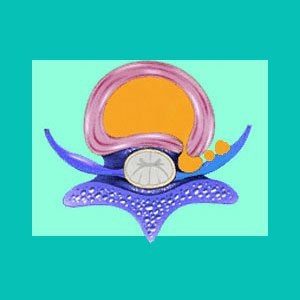
A sequestered disc is a term specifically used to describe a particular type of ruptured disc, which is a highly specific form of intervertebral herniation. When a piece of nucleus pulposus from an extruded disc actually breaks away from the whole disc structure, the herniation is described as being sequestered. In essence, what occurs in a sequestration is that part of the disc nucleus migrates away from the annulus. In some cases, this sequestered piece may remain whole, while in others, it may fragment into several or many smaller pieces.
This article will examine what actually occurs during a sequestration event and the possible negative consequences which may be produced on the nearby spinal structures.
Sequestered Disc Diagnosis
A sequestered condition can only be accurately diagnosed with advanced imaging techniques, such as an MRI or CT scan. X-rays will not be useful, since they do not clearly show soft tissues, such as intervertebral discs.
Sequestered herniated disc conditions typically do not present any worse symptoms than bulges or attached extrusions, and in some cases, a sequestration event might actually help to relieve symptoms due to a pinched nerve. Remember, as the piece of separated disc material migrates, it might move away from constricted nerve tissue and take pressure of any spinal structures currently being impinged upon. However, being that the nucleus material moves completely away from the disc structure, it may still affect nearby nerve tissue, possibly enacting chemical radiculitis in patients who are sensitive to the irritating disc proteins.
Sequestered Spinal Disc Treatment
Separated disc fragments generally do not enact foraminal stenosis on their own, since there is no force applied to these pieces from the disc structure. These pieces might be implicated in causing chemical radiculitis in some patients, although this remains a very controversial diagnostic theory.
Generally, sequestered spinal discs do not qualify for any form of treatment which might be more effective at dealing with a contained disc herniation, such as IDET, nucleoplasty and even most forms of non-surgical spinal decompression.
Symptomatic modalities are used in the same applications as for bulging discs, but are typically provided for pain relief, rather than curative potential. In circumstances where chemical irritation is theorized, multiple rounds of epidural flushing injections might be useful in dispersing the nucleus proteins, hopefully resolving the complaint.
Sequestered Disc Conclusions
Having a piece of a disc broken off and floating around the spinal column sounds bad and might be truly problematic in some instances. However, many sequestered conditions are no more symptomatic than any other type of herniated disc. Remember that all disc issues typically follow this simple rule:
Herniated discs that are caused by normal spinal degeneration are less likely to be symptomatic and many exist completely unbeknownst to the affected individual. Herniations due to traumatic injury are likely to be painful for a time of not more than 2 to 8 weeks, on average, but should resolve completely or near completely and are not likely to create persistent back pain syndromes.
If your pain has endured for months or years, despite treatment, there is a good chance that your sequestered intervertebral disc is nothing more than a scapegoat, being blamed for pain when all the while it is coincidental and innocent to the symptomatic expression. Talk to your neurologist to further explore this possibility.
Herniated Disc > What is a Herniated Disc > Sequestered Disc




